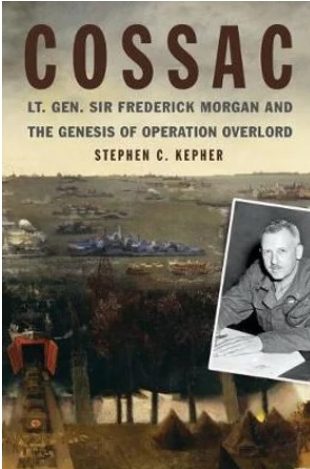LTGEN Sir Frederick Morgan and the Genesis of Operation Overlord
LTGEN Sir Frederick Morgan and the Genesis of Operation OverlordThe D-Day landings may go down in history forever as the greatest example of an amphibious landing. This is quite the feat for what started with “a couple of desks and chairs, a few sheets of paper and a pencil that someone had dropped on the floor”. The operation itself is often used as a case study for junior officers, and most recently was used in the Introduction to Joint Operations Course as an introduction, being described as the “best example in human history of a joint operation”. COSSAC was the name created by LTGEN Sir Frederick Morgan when he was tasked with the duty of planning for a cross-channel invasion in WWII. He was the Chief of Staff to the Supreme Allied Commander, despite a Commander not being appointed until December of 1943, six months prior to D-Day.
Kepher is a first-time author, who put pen to paper to tell this story of challenges and commitment and serves as a reminder that these operations do not simply “happen” and that perhaps we forget what goes on in the background.
We are introduced first to the concept of a cross-channel assault which sets the mind-set of the Combined Chiefs of Staff in 1943. Morgan, an artillery officer, is selected to lead the planning team effectively from scratch. Using the diaries of Morgan, Kepher tells of the struggles that were faced in the initial days particularly a lack of enthusiasm, significant doubt and more importantly, the fact that there was no Supreme Allied Commander to report to for quite some time. The confidence in opposed British amphibious landings in 1943 was still low noting the events several decades earlier at the Gallipoli campaign.
An engaging read, particularly when parallels to the current joint operational environment are drawn, as it shows the importance of understanding the intricacies of each service, their capabilities and even their language. It highlights to any junior officer of today just how important working and understanding the joint environment is and portrays Morgan as an excellent case study and role model. To refer again to the current Introduction to Joint Operations course, the Commandant of ADFTC states that “Australian military power will always be joint”.
For a first-time author, Kepher tells this story well in a logical manner. It is easy to follow and includes a glossary of terms and several appendices that outline the structure of the forces as well as a copy of the operational outline. Regardless of the reader’s knowledge of the operation, or even still, knowledge of military operations, no difficulty or over-use of military jargon is present. Some minor editorial errors were present in the format of missing letters from words; however, this did not detract from the reading experience.
A story of leadership, determination, networking, international engagement and an understanding of the broader operational picture, there is a lot to learn from the story of LTGEN Sir Morgan and COSSAC. A study into this story is a must for any junior officer early in their career, to understand how important it is to plan effectively and work in a joint environment. This book would serve well as a case study at the Australian Defence Force Academy through the Joint Military Education and Training program, prompting the future leaders of the ADF to think outside the box. This would drive home the importance of joint operations, proving that it is just as, if not more important now, than what it was in 1943.
About the reviewer
Lachlan Rowe is a Maritime Warfare Officer in the Royal Australian Navy, completing his Maritime Warfare Officer Course at HMAS Watson. Having completed a Bachelor of Business at the Australian Defence Force Academy in 2019, his passion for PME developed and he remains an advocate for the importance of pursuing PME opportunities at the Junior Officer Ranks. Follow Lachlan on Twitter at @R_owey.

